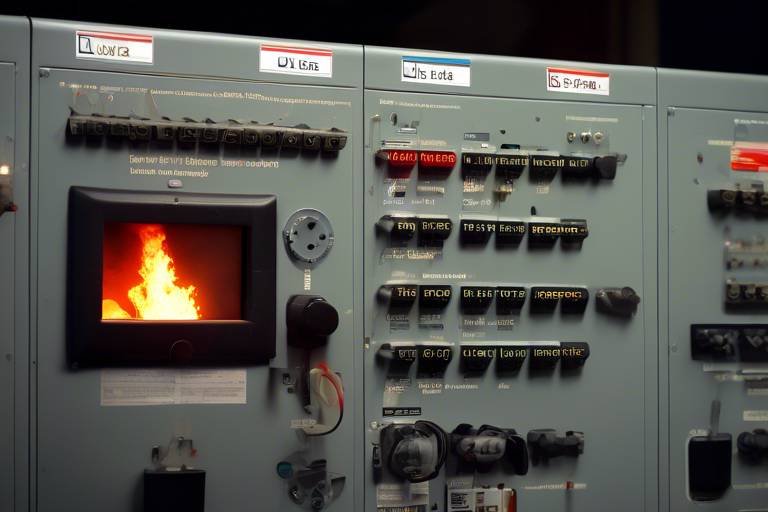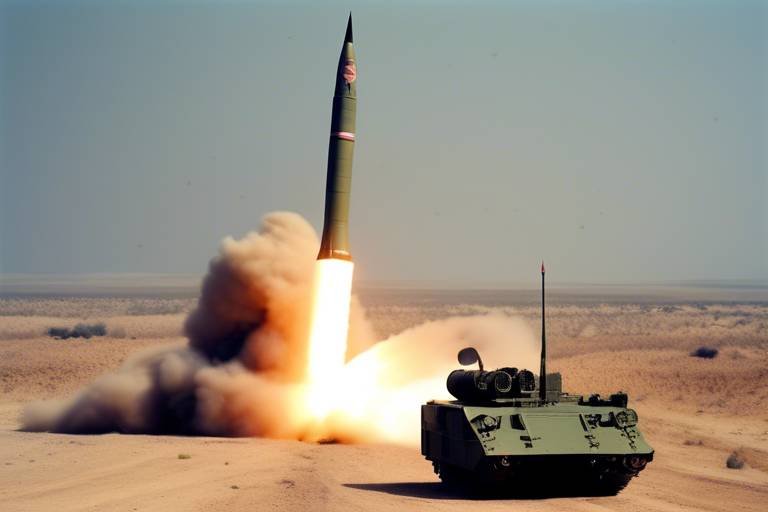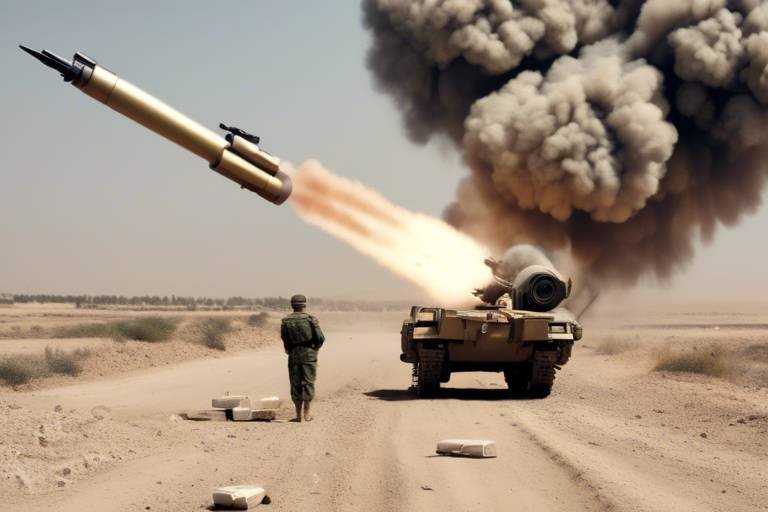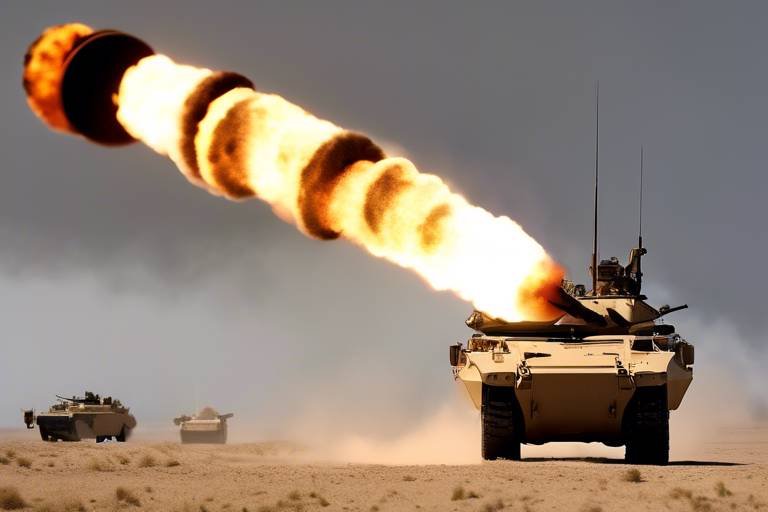The Significance of Data Links in Modern Fire Control Systems
In today's fast-paced world, the effectiveness of fire control systems is paramount, whether in military operations or civilian applications. At the heart of these systems lies a critical component: data links. These links serve as the communication lifeline, facilitating the seamless exchange of information between various elements of fire control systems. Imagine a well-orchestrated symphony where every instrument plays in perfect harmony; that's how data links function, ensuring that every piece of data is transmitted accurately and promptly. Without these links, the responsiveness and reliability of fire control systems would be severely compromised, leading to potential failures in critical operations.
Data links not only enhance situational awareness but also empower operators to make informed decisions in real-time. Think of them as the nervous system of a complex organism, transmitting vital signals that dictate actions and responses. In military scenarios, for instance, the ability to relay targeting information or changes in operational status can mean the difference between success and failure. Similarly, in civilian applications, such as firefighting or search and rescue missions, timely data transmission can save lives and resources. Therefore, understanding the significance of data links is essential for anyone involved in the development, maintenance, or operation of fire control systems.
Moreover, the evolution of technology has led to the emergence of various types of data links, each tailored to meet specific operational needs. From radio frequency systems that provide flexibility in communication to satellite links that ensure global coverage, the diversity of data link technologies enhances the overall performance of fire control systems. As we delve deeper into the types of data links, it becomes evident that each has its own set of advantages and challenges, making it crucial for operators to choose the right technology for their specific scenarios.
In summary, data links are not merely a component of fire control systems; they are the backbone that supports the entire structure. Their role in enhancing effectiveness, reliability, and efficiency cannot be overstated. As technology continues to advance, the importance of robust and reliable data links will only grow, paving the way for more sophisticated and capable fire control systems in the future.
- What are data links? Data links are communication pathways that enable the transmission of information between different components of fire control systems.
- Why are data links important? They ensure timely and accurate responses during critical operations, enhancing the overall effectiveness and reliability of fire control systems.
- What types of data links are commonly used? Common types include radio frequency, satellite, and fiber optic systems, each with unique advantages.
- What are the challenges associated with data links? Challenges can include interference, signal degradation, and vulnerability to physical damage, depending on the type of data link used.
Understanding Data Links
Data links are the unsung heroes in the realm of fire control systems. Think of them as the vital arteries that carry essential information between various components, ensuring that every part of the system works in harmony. When you consider the complexity of modern military and civilian operations, the importance of these communication pathways cannot be overstated. Without data links, the entire fire control operation would resemble a symphony without a conductor—chaotic and disorganized.
At their core, data links facilitate the timely and accurate transmission of information. They allow different systems to communicate with one another, whether it’s a ground-based control unit relaying data to an aerial drone or a naval vessel coordinating with an air support team. This communication is crucial during critical operations where every second counts. Imagine a fire control system that can’t share data in real-time; it would be like trying to drive a car without a steering wheel—impossible!
Data links come in various forms, each tailored to meet specific operational requirements. For instance, radio frequency (RF) links are often utilized in environments where mobility and flexibility are paramount. Meanwhile, satellite data links shine in scenarios requiring global coverage, making them indispensable for operations in remote areas. Then there are fiber optic links, which excel in delivering high-speed data with minimal latency, perfect for scenarios demanding rapid information transfer. The diversity of data links ensures that fire control systems can adapt to the unique challenges posed by different operational environments.
In summary, understanding data links is fundamental to grasping how modern fire control systems operate. They are not just conduits for information; they are the backbone of operational effectiveness, reliability, and efficiency. As technology continues to advance, the evolution of data links will undoubtedly play a pivotal role in enhancing the capabilities of fire control systems across various applications.
Types of Data Links
When we talk about data links, we're diving into a world of communication pathways that are essential for the smooth operation of fire control systems. These links are like the veins in a body, carrying vital information to ensure everything runs efficiently. There are several types of data links, each designed to meet specific needs and challenges in various operational environments. Let’s explore these types in detail, highlighting their unique benefits and the scenarios where they shine.
First up, we have Radio Frequency (RF) Data Links. Think of RF links as the wireless lifeline of fire control systems. They allow for real-time data exchange between components without the need for physical connections, which is crucial in dynamic situations. Imagine a military operation where troops need to coordinate their actions swiftly; RF data links enable them to communicate instantly, adapting to changing circumstances on the battlefield. This flexibility is what makes RF links a popular choice in many military applications.
Next, we turn our attention to Satellite Data Links. These are the superheroes of long-distance communication. Satellite links break down geographical barriers, providing global connectivity that is especially beneficial in remote or maritime environments. Picture a naval fleet operating in the middle of the ocean, far away from any land-based communication systems. Satellite links ensure that fire control systems can relay critical information back to command centers, keeping operations seamless even in the most isolated locations.
Finally, let’s not overlook Fiber Optic Data Links. If RF links are the wireless champions and satellites are the long-distance heroes, fiber optics are the speedsters of data transmission. With their ability to carry vast amounts of data at lightning-fast speeds, fiber optic links are ideal for scenarios requiring high bandwidth and low latency. Imagine a scenario where multiple sensors are feeding data into a fire control system; fiber optics can handle this data influx efficiently, ensuring that mission-critical information is processed and transmitted without delay.
In summary, the choice of data link depends on the specific operational requirements. Whether it’s the flexibility of RF links, the global reach of satellite connections, or the speed of fiber optics, each type plays a pivotal role in enhancing the effectiveness of fire control systems. Understanding these data link types is essential for anyone involved in the design or operation of modern fire control systems.
Radio Frequency Data Links
When we talk about Radio Frequency (RF) Data Links, we're diving into a world where communication meets technology in the most dynamic way. Imagine a bustling city where everyone is connected, exchanging information seamlessly—this is the essence of RF data links in fire control systems. These links empower various military and civilian applications by facilitating wireless communication that is both flexible and responsive, making them a crucial component in modern operations.
One of the standout features of RF data links is their ability to provide real-time data exchange. Picture a scenario where a military unit is engaged in a critical operation; the ability to instantly relay information about enemy positions or changes in the battlefield can mean the difference between success and failure. This instantaneous communication is not just a luxury; it's a necessity that RF links fulfill with remarkable efficiency.
In essence, RF data links operate by transmitting signals through the airwaves, which allows for communication over significant distances. This capability is particularly advantageous in military operations where units may be spread out over vast areas. The flexibility of RF links means that they can adapt to various environments, whether it’s a dense urban landscape or an open field, making them a reliable choice for fire control systems.
However, it's essential to recognize that while RF links offer incredible advantages, they are not without their challenges. For instance, interference from other electronic devices or natural obstacles can occasionally disrupt the signal. To combat these issues, advanced encryption and error correction methods are employed, ensuring that the communication remains secure and reliable. This is akin to having a strong lock on your door; it may not prevent every intruder, but it significantly reduces the risk of unauthorized access.
To summarize, RF data links are the backbone of modern fire control systems, providing the necessary communication framework that enhances operational effectiveness. Their ability to maintain connectivity in challenging environments and over long distances is invaluable. However, attention must be paid to their vulnerabilities, necessitating robust security measures to safeguard against potential disruptions. In the ever-evolving landscape of technology, RF data links continue to play a pivotal role in ensuring that fire control systems operate at peak performance.
Advantages of RF Links
This article explores the crucial role of data links in enhancing the effectiveness, reliability, and efficiency of contemporary fire control systems used in various military and civilian applications.
Data links are vital communication pathways that allow for the transmission of information between different components of fire control systems, ensuring timely and accurate responses during critical operations.
There are various types of data links, including radio frequency, satellite, and fiber optic systems, each offering unique advantages for different operational requirements in fire control scenarios.
Radio frequency data links provide wireless communication capabilities, enabling real-time data exchange between fire control systems and their platforms, enhancing operational flexibility and responsiveness.
When it comes to military operations, radio frequency (RF) links stand out for their remarkable advantages. One of the primary benefits is their ability to maintain communication over extensive distances. Imagine being in the middle of a vast desert or a dense forest; RF links ensure that you’re not cut off from your command center. This capability is crucial, especially when every second counts in high-stakes environments.
Moreover, RF links can operate effectively in challenging environments, whether it’s through rugged terrain or adverse weather conditions. They are designed to be resilient, which is essential for military operations where the unexpected can happen at any moment. Here are some of the key advantages of RF links:
- Flexibility: RF links can be deployed quickly and can adapt to various operational needs without the need for extensive infrastructure.
- Cost-Effectiveness: Compared to satellite or fiber optic systems, RF links can be less expensive to implement and maintain.
- Scalability: As operations expand, additional RF communication devices can be integrated easily, making them suitable for both small and large-scale missions.
These advantages make RF links a preferred choice for many military and emergency response applications, where rapid and reliable communication can make all the difference.
Despite their advantages, RF links can face interference and signal degradation, necessitating robust encryption and error correction methods to ensure reliable communication.
Satellite data links enable global connectivity, allowing fire control systems to communicate across vast distances, which is particularly beneficial for operations in remote or maritime environments.
Fiber optic data links offer high bandwidth and low latency, making them ideal for transmitting large volumes of data rapidly and securely in fire control systems.
The use of fiber optics in fire control systems significantly enhances data transmission speed and security, reducing the risk of interception and ensuring mission-critical information is delivered swiftly.
While fiber optics provide numerous benefits, they can be more vulnerable to physical damage and may require specialized infrastructure for installation and maintenance.
- What are data links?
Data links are communication pathways that enable the transmission of information between different components of fire control systems.
- Why are RF links important?
RF links are crucial for maintaining communication over long distances and in challenging environments, making them essential for military operations.
- What are the main challenges of using RF links?
RF links can face interference and signal degradation, which necessitates robust encryption and error correction methods.
- How do fiber optic links compare to RF links?
Fiber optic links offer high bandwidth and low latency but can be more vulnerable to physical damage compared to RF links.
Challenges of RF Links
This article explores the crucial role of data links in enhancing the effectiveness, reliability, and efficiency of contemporary fire control systems used in various military and civilian applications.
Data links are vital communication pathways that allow for the transmission of information between different components of fire control systems, ensuring timely and accurate responses during critical operations.
There are various types of data links, including radio frequency, satellite, and fiber optic systems, each offering unique advantages for different operational requirements in fire control scenarios.
Radio frequency data links provide wireless communication capabilities, enabling real-time data exchange between fire control systems and their platforms, enhancing operational flexibility and responsiveness.
RF data links are often favored for their ability to maintain communication over long distances and in challenging environments, making them essential in military operations.
While radio frequency (RF) data links offer significant advantages, they also come with a set of challenges that must be addressed to ensure reliable communication. One of the primary issues is interference. RF signals can be disrupted by various factors, including environmental conditions, physical obstructions, and even other electronic devices. This interference can lead to degraded signal quality, resulting in delays or loss of critical information during operations.
Another challenge is signal degradation. As RF signals travel over long distances, they can lose strength, making it difficult for receivers to interpret the data accurately. This degradation can be exacerbated in urban environments where buildings and structures can reflect or absorb signals, further complicating communication efforts.
Moreover, the security of RF links is a significant concern. Since RF communications can be intercepted, it is crucial to implement robust encryption methods to protect sensitive information from adversaries. Without adequate security measures, the risk of data breaches increases, potentially compromising mission success.
To mitigate these challenges, it is essential to incorporate error correction techniques and employ advanced modulation methods that can enhance the reliability of RF communications. Additionally, utilizing frequency hopping or spread spectrum technologies can help minimize the impact of interference, ensuring that fire control systems maintain effective communication even in challenging conditions.
Satellite data links enable global connectivity, allowing fire control systems to communicate across vast distances, which is particularly beneficial for operations in remote or maritime environments.
Fiber optic data links offer high bandwidth and low latency, making them ideal for transmitting large volumes of data rapidly and securely in fire control systems.
The use of fiber optics in fire control systems significantly enhances data transmission speed and security, reducing the risk of interception and ensuring mission-critical information is delivered swiftly.
While fiber optics provide numerous benefits, they can be more vulnerable to physical damage and may require specialized infrastructure for installation and maintenance.
- What are data links? Data links are communication pathways that transmit information between different components of fire control systems.
- What are the main types of data links? The main types include radio frequency, satellite, and fiber optic systems.
- What challenges do RF data links face? RF links can encounter interference, signal degradation, and security issues.
- How can RF link challenges be mitigated? Implementing error correction techniques and using advanced modulation methods can help improve reliability.
Satellite Data Links
When it comes to modern fire control systems, are nothing short of a game changer. They provide a robust means of communication that transcends geographical barriers, allowing for seamless data exchange across vast distances. Imagine being able to coordinate a military operation or manage emergency services in remote areas, all while relying on a network that operates high above the Earth. This is the power of satellite data links, and it’s transforming how we approach critical operations.
One of the standout features of satellite data links is their ability to maintain connectivity in situations where traditional communication methods might falter. Whether it’s a military mission in the middle of a desert or a humanitarian effort in a remote village, satellite links ensure that information flows freely and reliably. They act like a lifeline, bridging the gap between command centers and field units, which is essential for making informed decisions in real-time.
Moreover, satellite data links are particularly advantageous in maritime environments. Ships at sea often find themselves far from land-based communication infrastructure, making satellite links crucial for navigation, coordination, and safety. Picture a naval fleet operating in the open ocean; without satellite communication, they would be like ships lost in a storm, unable to relay critical information or receive updates from their command.
However, it's essential to recognize that satellite data links are not without their challenges. Factors such as weather conditions, satellite positioning, and signal latency can affect the quality of communication. For instance, heavy rain or storms can disrupt signals, leading to potential information delays. To mitigate these issues, advanced technologies and strategies are employed, ensuring that the benefits of satellite communication far outweigh the drawbacks.
In summary, satellite data links are an integral component of modern fire control systems, offering unparalleled connectivity and operational flexibility. They enable real-time communication in diverse environments, facilitating timely responses and enhancing overall mission effectiveness. As technology continues to evolve, we can expect even more improvements in satellite communication capabilities, further solidifying their role in both military and civilian applications.
- What are satellite data links? Satellite data links are communication channels that use satellites to transmit information between different systems, enabling global connectivity.
- How do satellite data links benefit military operations? They provide reliable communication over vast distances, ensuring timely coordination and response in various operational environments.
- Are there any limitations to satellite data links? Yes, challenges such as weather interference and signal latency can affect communication quality, but advancements in technology are continuously addressing these issues.
Fiber Optic Data Links
Fiber optic data links are revolutionizing the way fire control systems operate, providing a level of performance and reliability that is essential in both military and civilian applications. These links utilize light to transmit data through thin strands of glass or plastic fibers, which allows for incredibly high-speed communication over long distances. Imagine sending a message at the speed of light—this is the essence of fiber optics! The impact of such technology cannot be overstated, as it dramatically enhances the efficiency of fire control systems, ensuring that critical information is relayed swiftly and accurately.
One of the most significant advantages of fiber optic data links is their high bandwidth. This means they can handle vast amounts of data simultaneously, which is crucial in scenarios where real-time information is vital. For instance, in a military operation, commanders need to receive updates on troop movements, equipment status, and environmental conditions without delay. Fiber optics make this possible, allowing for seamless communication between various units and command centers. Additionally, the low latency associated with fiber optic links ensures that there is minimal delay in data transmission, which can be the difference between success and failure in critical situations.
Security is another area where fiber optic data links shine. Because they transmit data via light, they are inherently less susceptible to eavesdropping compared to traditional copper cables. This characteristic makes them an attractive option for fire control systems that handle sensitive information. In fact, the use of fiber optics can significantly reduce the risk of interception, ensuring that mission-critical data remains confidential. For military applications where operational security is paramount, this feature is invaluable.
However, it's important to acknowledge that fiber optic data links do come with their own set of challenges. One major limitation is their vulnerability to physical damage. Unlike RF or satellite links, which can operate in various environmental conditions, fiber optic cables can be easily cut or damaged if not properly protected. This makes it essential for organizations to invest in robust infrastructure and protective measures to safeguard these cables, especially in hostile or unpredictable environments.
Moreover, the installation and maintenance of fiber optic systems can be more complex and costly compared to other types of data links. Specialized training and equipment are often required to handle fiber optics safely and effectively. Despite these challenges, the benefits of fiber optic data links in fire control systems far outweigh the drawbacks, making them a preferred choice for many modern applications.
In conclusion, fiber optic data links are a game-changer for fire control systems, offering unparalleled speed, security, and reliability. As technology continues to evolve, the integration of fiber optics will likely play an even more prominent role in enhancing the capabilities of these systems. By investing in fiber optic technology, organizations can ensure that they remain at the forefront of operational effectiveness, ready to tackle the challenges of today and tomorrow.
- What are fiber optic data links?
Fiber optic data links use light transmitted through thin strands of glass or plastic to communicate data quickly and securely over long distances. - What are the advantages of using fiber optics in fire control systems?
They offer high bandwidth, low latency, and enhanced security, making them ideal for transmitting large volumes of sensitive data rapidly. - What challenges do fiber optic data links face?
They can be vulnerable to physical damage and require specialized infrastructure for installation and maintenance.
Benefits of Fiber Optics
When it comes to modern fire control systems, fiber optic data links stand out as a game-changer. These systems are not only faster but also more secure than traditional communication methods. Imagine trying to send a message through a crowded room; that’s what conventional systems often face—interference and noise. In contrast, fiber optics act like a clear, unobstructed tunnel, allowing data to flow seamlessly and efficiently. This clarity is crucial in high-stakes environments where every second counts.
One of the most significant advantages of fiber optics is their high bandwidth capacity. This means they can carry a large amount of data at once, which is essential for fire control systems that require real-time information. For example, consider a military operation where multiple sensors are feeding data back to a command center. Fiber optics can handle this influx of information without breaking a sweat, ensuring that decision-makers have access to all the intel they need to respond swiftly.
Moreover, the low latency of fiber optic systems cannot be overstated. In a world where milliseconds can determine the outcome of a mission, having a communication system that transmits information almost instantaneously is a massive advantage. Think of it like racing cars on a track; the faster they can communicate their positions and speeds, the better they can strategize and avoid collisions.
Security is another area where fiber optics excel. Data transmitted through fiber optic cables is inherently more secure than that sent over traditional copper wires. Why? Because fiber optics use light to transmit data, making it extremely difficult for unauthorized users to tap into the line without being detected. This is particularly important in military operations where sensitive information must remain confidential. To illustrate this point, consider the following comparison:
| Communication Method | Bandwidth | Latency | Security |
|---|---|---|---|
| Fiber Optics | High | Low | Very High |
| Copper Wires | Moderate | High | Moderate |
However, it’s essential to acknowledge that while fiber optics offer numerous benefits, they are not without their challenges. For instance, the infrastructure required for fiber optics can be more complex and costly to install compared to traditional systems. Additionally, fiber optic cables are more susceptible to physical damage, which can be a concern in rugged environments. Nevertheless, the advantages they bring to fire control systems far outweigh these limitations, making them an invaluable asset in both military and civilian applications.
- What are fiber optics? Fiber optics are thin strands of glass or plastic that transmit data as light signals, allowing for high-speed communication.
- Why are fiber optics preferred in fire control systems? They offer high bandwidth, low latency, and enhanced security, making them ideal for transmitting critical information quickly and securely.
- Are there any disadvantages to using fiber optics? Yes, they can be more vulnerable to physical damage and require specialized infrastructure for installation.
Limitations of Fiber Optics
While fiber optic data links bring a plethora of advantages to fire control systems, they are not without their own set of limitations. One major drawback is their vulnerability to physical damage. Unlike traditional copper wires, which can withstand a fair amount of wear and tear, fiber optics are made of glass. This means that they can easily break or fracture if subjected to excessive force or impact. Imagine stepping on a delicate glass ornament; the fragility of fiber optics is similar in that they require careful handling and installation to avoid costly repairs.
Moreover, the installation of fiber optic systems often demands specialized infrastructure and expertise. This can lead to increased costs and time delays in setting up fire control systems, particularly in remote or rugged environments where accessibility is limited. Technicians trained in fiber optic technology are essential for both installation and maintenance, which can sometimes pose a challenge in areas where such expertise is scarce.
Another consideration is the cost of materials. While the prices have been decreasing over the years, fiber optic cables and the necessary components for their deployment can still be more expensive compared to conventional wiring options. This financial aspect can be a significant factor for organizations operating under tight budgets, especially when weighing the benefits against the costs.
Additionally, while fiber optics offer high bandwidth and low latency, they are susceptible to issues related to signal attenuation. Over long distances, the strength of the signal can diminish, requiring the use of repeaters to boost the signal back to optimal levels. This can complicate the design of fire control systems, particularly in extensive operational areas where maintaining signal integrity is crucial.
In summary, while fiber optic data links are a powerful tool in enhancing the efficiency and reliability of fire control systems, their limitations—such as physical fragility, installation challenges, costs, and signal attenuation—must be carefully considered. Organizations must weigh these factors against the benefits to determine if fiber optics are the right choice for their specific needs.
- What are fiber optic data links used for?
Fiber optic data links are primarily used for high-speed data transmission in various applications, including fire control systems, telecommunications, and internet connectivity.
- How do fiber optic cables compare to traditional copper cables?
Fiber optic cables provide higher bandwidth, faster data transmission speeds, and better security compared to traditional copper cables, but they are more fragile and can be costlier to install.
- Can fiber optic cables be used outdoors?
Yes, fiber optic cables can be used outdoors, but they require protective coatings and enclosures to safeguard against environmental factors.
- What maintenance is required for fiber optic systems?
Regular inspections and cleaning of connectors are essential for maintaining fiber optic systems, along with monitoring for any physical damage.
Frequently Asked Questions
- What are data links in fire control systems?
Data links are essential communication pathways that facilitate the exchange of information between various components of fire control systems. They ensure that critical data is transmitted in real-time, enabling timely and accurate responses during operations.
- What types of data links are commonly used?
There are several types of data links utilized in fire control systems, including radio frequency (RF), satellite, and fiber optic systems. Each type has its unique advantages tailored to different operational needs.
- What are the advantages of radio frequency data links?
RF data links are known for their wireless communication capabilities, allowing for real-time data exchange over long distances. They are particularly beneficial in military operations where operational flexibility and responsiveness are crucial.
- What challenges do radio frequency links face?
Despite their many benefits, RF links can encounter issues such as interference and signal degradation. To combat these challenges, robust encryption and error correction methods are necessary to maintain reliable communication.
- How do satellite data links enhance fire control systems?
Satellite data links provide global connectivity, enabling fire control systems to communicate over vast distances. This capability is especially valuable for operations in remote or maritime environments where traditional communication methods may fail.
- What are the benefits of using fiber optic data links?
Fiber optic data links offer high bandwidth and low latency, making them ideal for rapidly transmitting large volumes of data securely. This ensures that mission-critical information is delivered swiftly and reduces the risk of interception.
- Are there any limitations to fiber optic data links?
While fiber optics provide numerous advantages, they can be more vulnerable to physical damage and may require specialized infrastructure for installation and maintenance. This can pose challenges in certain operational scenarios.



















